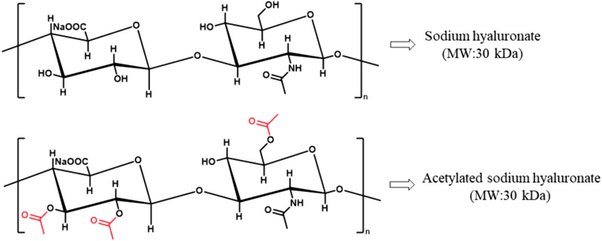Introduction
Knowing the differences between hyaluronic acid derivatives can help one choose skincare products for more specific applications. This article considers the unique properties, synthesis, and applications of Sodium Acetylated Hyaluronate, Hydrolyzed Hyaluronic Acid, and Sodium Hyaluronate—three popular skincare ingredients.
Understanding Sodium Acetylated Hyaluronate
Sodium acetylated hyaluronate is a derivative that is formed by the introduction of an acetyl group into the molecule of sodium hyaluronate. The repeating units constituting this hyaluronic acid itself are glucuronic acid and N-acetyl glucosamine. In hyaluronic acid, an acetyl group will be introduced through a chemical modification in its chain to enhance its lipophilicity so that it could easily get absorbed and utilized by skin.

Fig 1. Sodium Acetylated Hyaluronate Chemical Structure
–Physical and Chemical Properties
The introduction of the acetyl group has a slight impact on decreasing the solubility of Sodium Acetylated Hyaluronate in water compared to regular sodium hyaluronate; however, its lipophilicity is greatly enhanced. This modification gives it stronger moisturizing capabilities and a better skin feel, with enhanced softness and spreadability.
–Functions and Applications:
Sodium Acetylated Hyaluronate has its most popular features in superior moisturizing and soothing. It can form a soft protective film on the skin surface to prevent moisture loss. Besides, it is also able to soften dry and irritated skin with its anti-inflammatory properties. Its high degree of permeability allows it to penetrate further into skin layers, repair the skin barrier, enhance skin softness, and smoothness. Because of this, it is widely used in top-grade skincare products, repair masks, serums, and anti-aging products.
Explore Hydrolyzed Hyaluronic Acid
After hydrolysis through acidic or enzymatic means, large molecular chains of hyaluronic acid are formed into fragments of low molecular weight. This includes a molecular weight usually between 1-50 kilodaltons (kDa), much lower in molecular weight when contrasted with unhydrolyzed hyaluronic acid.
–Physical and Chemical Properties
Its hydrolyzed molecular weight reduces to enhance its water solubility, allowing it to diffuse into the skin barrier and reach the dermal layer. The small molecular structure allows this component to diffuse more rapidly in the skin, thereby getting more easily absorbed by the cells.
–Functions and applications
Hydrolyzed Hyaluronic Acid is generally incorporated into skincare products for deep hydration, anti-aging, and skin repair. Since it is more easily able to penetrate deeper into the skin, it works by stimulating collagen synthesis, which improves skin elasticity and brightness and decreases thinning lines and wrinkles. It has the ability to heal wounds and decrease inflammation, making it a common ingredient in anti-aging serums, hydration masks, and high-performance repair products.
Get to know Hyaluronic Acid
The sodium salt version of hyaluronic acid is sodium hyaluronate. It arises from the reaction between the carboxyl group (COOH) of hyaluronic acid and sodium ions (Na+). On its own, hyaluronic acid is a high molecular weight polymer of glycosaminoglycans, characterized by its very high hydrophilicity.

Fig 2. The structures of sodium hyaluronate and its acetylated form.
–Physical and Chemical Properties:
Sodium Hyaluronate is highly water-soluble, associative with many times its weight in water to form a viscid liquid with a gel-like appearance, and thus can generate outstanding surface moisturizing effects for skincare products. It generally has a large molecular weight, on the order of hundreds of thousands to several million daltons, and remains mostly on the skin surface.
–Functions and Applications:
Sodium Hyaluronate is widely used as a moisturizer in skincare products. This ingredient is applied for creams, lotions, masks, and eye creams. Sodium Hyaluronate forms a thin film on the skin surface, thereby locking the moisture in, avoiding dryness and dehydration, and maintaining the skin’s softness and smoothness. Apart from providing moisturizing features, the Sodium Hyaluronate ingredient has some soothing and anti-inflammatory effects that make it suitable for use on all skin types, but in particular for dry, sensitive, and damaged skin.
Table 1. Comparison of Hyaluronic Acid Derivatives
| Property | Sodium Acetylated Hyaluronate | Hydrolyzed Hyaluronic Acid | Sodium Hyaluronate |
| Molecular Weight | Enhanced penetration, | Lowest molecular weight | Larger molecules |
| Penetration | reaches mid-layers | penetrates deep | stays on the surface |
| Moisturizing Ability | Strong hydration, forms lasting moisture film | Deep hydration, retains moisture in deeper layers | Surface hydration, forms a light moisture layer |
| Anti-Aging & Repair | Effective anti-aging, repairs skin barrier | Promotes collagen, strong repair, reduces wrinkles | Indirect anti-aging through hydration, less effective |
| Soothing & Anti-Inflammation | Good anti-inflammatory, suitable for sensitive skin | Moderate soothing, aids in healing | Mild soothing for minor inflammation |
| Skin Type Suitability | For dry,sensitive,damaged,aging skin | Suitable for all skin types, especially mature | Suitable for all skin types, basic hydration |
| Cost | Expensive | High cost | Lower cost |
| Product Positioning | high-end products | anti-aging and high-performance products | widely used in basic skincare |
Table 1 compares the performance and effects of Sodium Acetylated Hyaluronate, Hydrolyzed Hyaluronic Acid, and Sodium Hyaluronate across several properties. You can review the detailed comparison in the table provided.
Conclusion
- Sodium Acetylated Hyaluronate: The acetylated sodium hyaluronate has better lipophilicity and permeability and is suitable for deep moisturizing and soothing repair.
- Hydrolyzed Hyaluronic Acid: Low molecular weight hyaluronic acid after hydrolysis, which has an excellent moisturizing, anti-aging, and skin elasticity-enhancing capability from the inside out.
- Sodium Hyaluronate: This conventional sodium hyaluronate offers basic surface moisturizing and is very broadly used in various skin care products.
Stanford Chemical Company (SCC) is a trusted supplier of Sodium Hyaluronate Powder. We provide customers with high purity, non-animal, non-GMO Hyaluronic Acid powder, Sodium Acetylated Hyaluronate Powder. Enjoy bulk purchase discounts and contract pricing.
Related articles:
Solubility of Hyaluronic Acid in Different Solvents and Its Influencing Factors
Is Sodium Hyaluronate And Hyaluronic Acid The Same Thing
Reference:
Chen, Fan & Guo, Xueping & Wu, Yue. (2023). Skin antiaging effects of a multiple mechanisms hyaluronan complex. Skin Research and Technology. 29. 10.1111/srt.13350.

